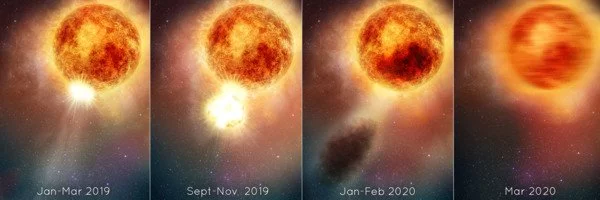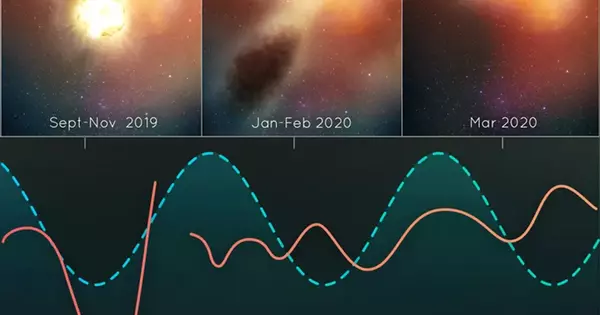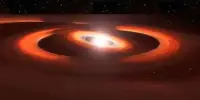Betelgeuse appears as a brilliant, ruby-red, twinkling spot of light in the upper right shoulder of Orion the Hunter in the winter sky. Close inspection reveals it to be a seething monster with a 400-day-long heartbeat of regular pulsations. This aging star is classified as a supergiant because it has grown to an incredible diameter of approximately 1 billion miles. If placed in the center of our solar system, it would reach Jupiter’s orbit.
The star will eventually explode as a supernova. When this occurs, it will be briefly visible in the daytime sky from Earth. But, before the final detonation, there are a lot of fireworks going off. Astronomers using Hubble and other telescopes have deduced that the star blew off a huge piece of its visible surface in 2019.
This has never been seen on a celebrity before. Our obstinate Sun routinely undergoes mass ejections of its outer atmosphere, the corona. However, those events are orders of magnitude weaker than what was observed on Betelgeuse. The first hint appeared when the star mysteriously darkened in late 2019. As the ejected surface cooled, it created a massive cloud of obscuring dust. Astronomers have now pieced together a scenario for the upheaval. And the star is still slowly recovering; the photosphere is rebuilding itself. And the interior is ringing like a sledgehammer, disrupting the star’s normal cycle. This doesn’t mean the monster star is going to explode any time soon, but the late-life convulsions may continue to amaze astronomers.
Astronomers have concluded that the bright red supergiant star Betelgeuse literally blew its top in 2019, losing a significant portion of its visible surface and producing a massive Surface Mass Ejection after analyzing data from NASA’s Hubble Space Telescope and several other observatories (SME). This has never been seen before in the behavior of a normal celebrity.
We’ve never seen such a large mass ejection from the surface of a star. We are left with something going on that we do not fully comprehend. It’s a completely new phenomenon that we can directly observe and resolve surface details with Hubble. We’re witnessing the evolution of stars in real time.
Fred L. Whipple
In an event known as a Coronal Mass Ejection, our Sun routinely blows off parts of its tenuous outer atmosphere, the corona (CME). However, the Betelgeuse SME ejected 400 billion times the mass of a typical CME!
The monster star is still slowly recovering from this catastrophic upheaval. “Betelgeuse continues doing some very unusual things right now; the interior is sort of bouncing,” said Andrea Dupree of the Center for Astrophysics | Harvard & Smithsonian in Cambridge, Massachusetts.
These new findings shed light on how red stars lose mass as their nuclear fusion furnaces burn out before exploding as supernovae. The amount of mass lost has a significant impact on their fate. Betelgeuse’s surprisingly petulant behavior, on the other hand, is not evidence that the star is about to explode anytime soon. As a result, the mass loss event is not always indicative of an impending explosion.
Dupree is now piecing together the star’s petulant behavior before, after, and during the eruption into a coherent story of a never-before-seen titanic convulsion in an aging star.
This includes new spectroscopic and imaging data from the STELLA robotic observatory, the Fred L. Whipple Observatory’s Tillinghast Reflector Echelle Spectrograph (TRES), NASA’s Solar Terrestrial Relations Observatory spacecraft (STEREO-A), NASA’s Hubble Space Telescope, and the American Association of Variable Star Observers (AAVSO). Dupree emphasizes that the Hubble data was pivotal to helping sort out the mystery.

“We’ve never seen such a large mass ejection from the surface of a star. We are left with something going on that we do not fully comprehend. It’s a completely new phenomenon that we can directly observe and resolve surface details with Hubble. We’re witnessing the evolution of stars in real time.”
The 2019 titanic outburst was possibly caused by a convective plume more than a million miles across bubbling up from deep within the star. It created shocks and pulsations that blasted the chunk of photosphere away, leaving the star with a large cool surface area beneath the dust cloud created by the cooling piece of photosphere. Betelgeuse is currently struggling to recover from this injury.
Weighing roughly several times as much as our Moon, the fractured piece of photosphere sped off into space and cooled to form a dust cloud that blocked light from the star as seen by Earth observers. The dimming, which began in late 2019 and lasted for a few months, was easily noticeable even by backyard observers watching the star change brightness. One of the brightest stars in the sky, Betelgeuse is easily found in the right shoulder of the constellation Orion.
Even more amazing, the supergiant’s 400-day pulsation rate has vanished, at least temporarily. For nearly 200 years, astronomers have observed this rhythm in changes in Betelgeuse’s brightness variations and surface motions. Its destruction attests to the ferocity of the blowout.
The star’s interior convection cells, which drive the regular pulsation, may be sloshing around like an unbalanced washing machine tub, according to Dupree. TRES and Hubble spectra indicate that the outer layers have returned to normal, but the surface is still bouncing like a plate of gelatin dessert as the photosphere rebuilds itself.
Though our Sun has coronal mass ejections that blow off small pieces of its outer atmosphere, astronomers have never seen such a large portion of a star’s visible surface blasted into space. As a result, surface mass ejections and coronal mass ejections may be distinct events.
Betelgeuse is now so massive that if it replaced the Sun at the center of our solar system, its outer surface would extend beyond Jupiter’s orbit. In 1996, Dupree used Hubble to resolve hot spots on the surface of the star. This was the first direct image of a star other than the Sun. NASA’s Webb Space Telescope may be able to detect the ejected material in infrared light as it moves away from the star.
















